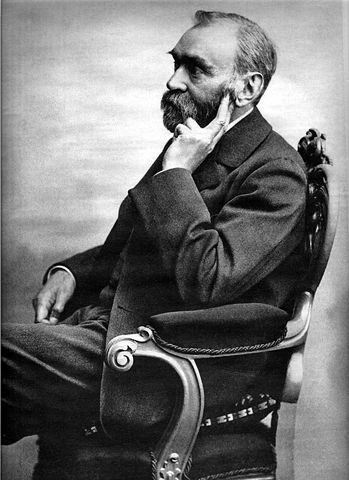The Merchant of Medals

The Nobel Prizes are named for Alfred Nobel, a Swedish chemist and inventor (pictured) who, over the course of his career, obtained roughly 350 patents. Many people know this already — and if you don’t, it’s a fun fact in and of itself — but either way, Nobel’s most famous invention was dynamite. (Not “dynamite” as in “exciting!” but “dynamite” as in the stuff that the coyote uses to try to kill the road runner.) That hardly seems like the type of thing that the world’s pre-eminent Peace Prize is named for, and unfortunately, the story gets worse before it gets better. One of the first casualties of Nobel’s inventions was his younger brother Emil, who died in a factory explosion in 1864; Alfred, who had invented a nitroglycerin detonator a year prior, was developing improved explosives and something went wrong, claiming the lives of Emil and four others. Undeterred, Nobel plugged onward. Over the course of his lifetime, he would end up revolutionizing the universe of blowing things up, building 90 armament factories along the way, making him sound more like a sadist than a man for all ages.
And if it weren’t for an awkward editorial error, he may have continued on that path.
Nobel died in 1888 while visiting Cannes, France. Being rich and famous, his death was apparently announced via a prominent newspaper obituary stating, bluntly, “le marchand de mort est mort” — “the merchant of death is dead.” It described the destruction he, his inventions, and his factories had caused, and the death toll they were responsible for. According to TIME, the obit (translated), pulled no punches: “Dr. Alfred Nobel, who became rich by finding ways to kill more people faster than ever before, died yesterday.” It was a brutal send off for a brutal man, as anyone who read it certainly concluded.
It was mostly accurate, too, except for one massive flaw. Nobel did, in fact, die the day before the obituary’s publication. But not Alfred Nobel. It was his brother Ludvig who passed away a day earlier. Readers throughout the area were met with the story of evil Alfred, though, and in at least one case, that depiction left a lasting impression on the reader. The good news for Alfred Nobel, and the world at large, is that the reader in question was Alfred Nobel himself. And he wasn’t too happy about it.
Nobel spent much of the rest of his life trying to avoid the horrible legacy portended by the erroneous obituary. In September of 1895, unbeknownst to his heirs, he revised his will to leave over 90% of his fortune — accounting for inflation, roughly $250 million (but in Swedish kronor) — to establish what is now known as the Nobel Prizes.
Bonus fact: Famed American actress Elizabeth Taylor died on March 23, 2011. Before the day was out, the New York Times published on its website a 4,000 word obituary encapsulating her life. (It’s here.) The turn around time may seem incredibly fast, but it turns out, the opposite was true. The obit was written, primarily, by Mel Gussow, a man whose career at the Times spanned 35 years. But he wasn’t working for them on March 23, 2011 — he died in 2005. The Times simply held publication until Ms. Taylor died, even though the obituary’s author predeceased her by more than half a decade.
Double bonus!: If you teach at the University of California, Berkeley, and win a Nobel, you get the admiration (and likely jealous eye) of your peers — and, a free parking spot for the rest of your tenure. You have to renew the permit annually, however. (You don’t have to win another Nobel in order to renew it. That’d be crazy.)
From the Archives: Dissolving Medals: How a pair of Nobel Laureates hid their medals from the Nazis.
Related: “The Impossible Takes Longer: The 1,000 Wisest Things Ever Said by Nobel Prize Laureates” by David Pratt, who is not himself a Nobel Laureate. Three reviews, each of which is of five stars.
